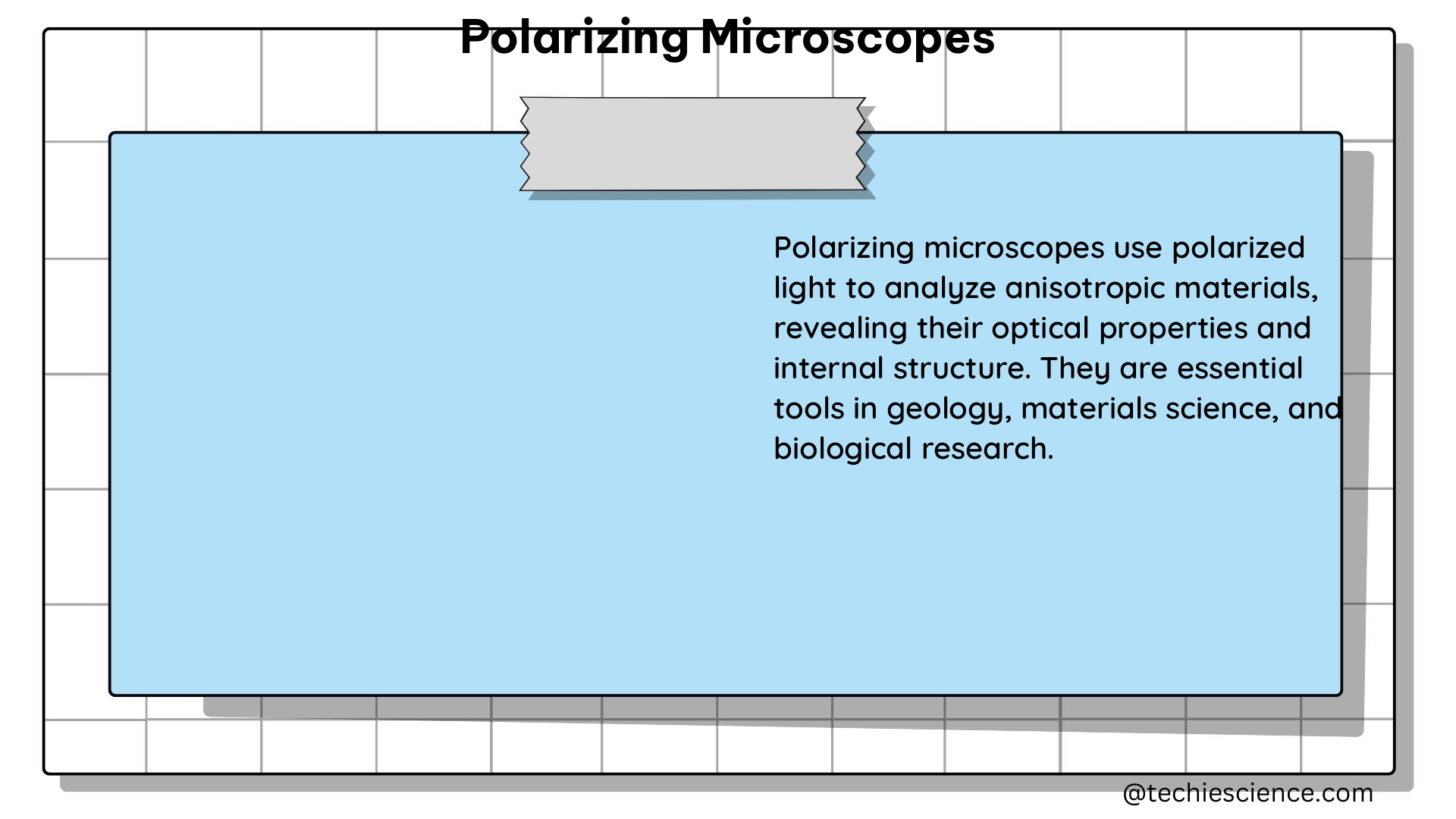Polarizing microscopes are highly specialized instruments that utilize polarized light to observe and analyze optically anisotropic specimens. These microscopes are equipped with unique components, such as a polarizer, analyzer, and retardation plates, which enhance the contrast and visibility of birefringent materials. The interaction of plane-polarized light with a birefringent specimen produces two individual wave components, known as the ordinary and extraordinary wavefronts, which exhibit different propagation velocities and result in a phase difference upon exiting the specimen. This phase difference is recombined with constructive and destructive interference when the light passes through the analyzer, producing image contrast.
Understanding the Principles of Polarized Light Microscopy
Polarized light microscopy is a powerful technique that provides detailed information about the structure and properties of optically anisotropic specimens. This contrast-enhancing method offers several advantages over other microscopy techniques, such as darkfield, brightfield, differential interference contrast, phase contrast, Hoffman modulation contrast, and fluorescence.
Optical Components and Alignment
The polarizing microscope is equipped with a polarizer, which is positioned in the light path before the specimen, and an analyzer, which is placed in the optical pathway between the objective rear aperture and the observation tubes or camera port. Proper alignment of these components is crucial for achieving maximum specimen birefringence and brightness on a dark background, a condition known as maximum extinction.
To ensure accurate centering and alignment, polarizing microscopes often include a circular graduated stage that allows for 360-degree rotation of the specimen. Additionally, the microscope may be equipped with advanced optical components, such as a full-wave retardation plate, quartz wedge, Berek compensator, or quarter-wavelength plate, which can be inserted into the microscope body or intermediate tube for more sophisticated analyses.
Quantitative Analysis and Calibration
For quantitative analysis in polarized light microscopy, precise centering of the stage and all objectives is essential. This ensures that the transmission axes of the analyzer and polarizer are crossed at a 90-degree angle, which is the condition for maximum specimen birefringence and brightness on a dark background.
To achieve proper alignment of the polarizer and analyzer axes, a polarized light microscope orientation plate can be used. This plate contains a rectangular thin birefringent crystal with an optical axis parallel to the long edge of the crystal. When the long axis of the crystal is oriented at a 45-degree angle to the polarizer and analyzer transmission azimuths, maximum birefringence is observed in polarized light, allowing for accurate calibration and alignment.
Theoretical Foundations and Formulas

The interaction of polarized light with a birefringent specimen is governed by several key principles and formulas:
Phase Difference Calculation
The phase difference (Δφ) between the ordinary and extraordinary wavefronts can be calculated using the formula:
Δφ = (2π/λ) × d × (n_e – n_o)
Where:
– λ is the wavelength of light
– d is the thickness of the specimen
– n_e and n_o are the extraordinary and ordinary refractive indices, respectively
Birefringence Determination
The birefringence (Δn) of a specimen can be determined by measuring the retardation (R) using a retardation plate or compensator and the formula:
Δn = R/d
Where:
– d is the thickness of the retardation plate or compensator
Physics Examples and Numerical Problems
Example 1:
A birefringent crystal with a thickness of 0.01 mm and extraordinary and ordinary refractive indices of 1.55 and 1.52, respectively, is illuminated with light of wavelength 550 nm. Calculate the phase difference between the ordinary and extraordinary wavefronts.
Solution:
Using the formula Δφ = (2π/λ) × d × (n_e – n_o), we get:
Δφ = (2π/550 nm) × 0.01 mm × (1.55 – 1.52) = 0.012 radians
Example 2:
A quartz wedge with a thickness of 0.02 mm is used as a retardation plate in a polarizing microscope. If the birefringence of quartz is 0.009, calculate the retardation introduced by the wedge.
Solution:
Using the formula R = Δn × d, we get:
R = 0.009 × 0.02 mm = 0.00018 mm = 180 nm
Numerical Problem 1:
A birefringent crystal with a thickness of 0.02 mm and extraordinary and ordinary refractive indices of 1.58 and 1.55, respectively, is illuminated with light of wavelength 600 nm. Calculate the phase difference between the ordinary and extraordinary wavefronts.
Numerical Problem 2:
A mica sheet with a thickness of 0.015 mm is placed in a polarizing microscope equipped with a full-wave retardation plate. If the birefringence of mica is 0.002, calculate the retardation introduced by the mica sheet.
Figures, Data Points, Values, and Measurements
- The thickness of a birefringent specimen can range from a few micrometers to several millimeters, depending on the material and application.
- The refractive indices of birefringent materials can vary widely, with typical values ranging from 1.3 to 1.8 for ordinary refractive indices and from 1.4 to 2.0 for extraordinary refractive indices.
- The wavelength of light used in polarizing microscopy typically ranges from 400 to 700 nm, covering the visible spectrum.
- The retardation introduced by a retardation plate or compensator can range from a few nanometers to several micrometers, depending on the material and thickness of the plate.
References
- Polarized Light Microscopy | Nikon’s MicroscopyU. (n.d.). Retrieved from https://www.microscopyu.com/techniques/polarized-light/polarized-light-microscopy
- Polarized Light Microscopy – Microscope Configuration | Olympus LS. (n.d.). Retrieved from https://www.olympus-lifescience.com/en/microscope-resource/primer/techniques/polarized/configuration/
- Polarized Light Microscopy – Microscope Alignment | Olympus LS. (n.d.). Retrieved from https://www.olympus-lifescience.com/en/microscope-resource/primer/techniques/polarized/polmicroalignment/

The lambdageeks.com Core SME Team is a group of experienced subject matter experts from diverse scientific and technical fields including Physics, Chemistry, Technology,Electronics & Electrical Engineering, Automotive, Mechanical Engineering. Our team collaborates to create high-quality, well-researched articles on a wide range of science and technology topics for the lambdageeks.com website.
All Our Senior SME are having more than 7 Years of experience in the respective fields . They are either Working Industry Professionals or assocaited With different Universities. Refer Our Authors Page to get to know About our Core SMEs.